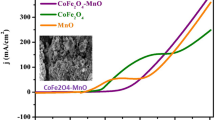Abstract
Nafion- and clay-coated electrodes are prepared by casting a known amount of Nafion and clay solutions on the glassy carbon electrode (GC) surface. Subsequently platinum (Pt) particles are deposited on the GC electrodes and on the Nafion- and clay-coated GC electrodes. The formation of Pt particles on the modified electrode surface is analysed by scanning electron microscope, while cyclic voltammetry provides information on the anodisation of Pt particles deposited on the GC electrodes at >0.5 V(SCE) leading to the formation of platinum oxide (PtO). The involvement of PtO on the catalysed dioxygen reduction to hydrogen peroxide is reported. Macrocyclic cobalt(III) complex is also used as the electrocatalyst. The effect of pH on the reduction of PtO and dioxygen in deaerated and oxygenated solutions is studied to understand the dioxygen reduction processes.
Similar content being viewed by others
Author information
Authors and Affiliations
Additional information
Received: 24 January 1997 / Accepted: 14 April 1997
Rights and permissions
About this article
Cite this article
Premkumar, J., Ramaraj, R. Electrocatalytic reduction of dioxygen at platinum particles deposited on Nafion- and clay-coated electrodes. J Solid State Electrochem 1, 172–179 (1997). https://doi.org/10.1007/s100080050042
Published:
Issue Date:
DOI: https://doi.org/10.1007/s100080050042




